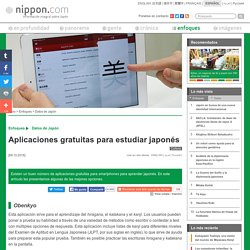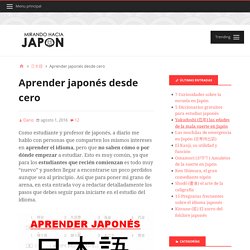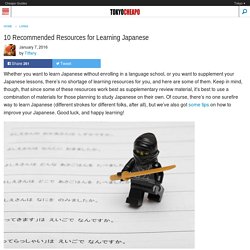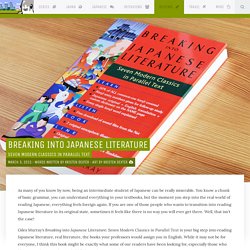

Tofugu. Aplicaciones gratuitas para estudiar japonés. Obenkyo Esta aplicación sirve para el aprendizaje del hiragana, el katakana y el kanji.

Los usuarios pueden poner a prueba su habilidad a través de una variedad de métodos como escribir o contestar a test con múltiples opciones de respuesta. Esta aplicación incluye listas de kanji para diferentes niveles del Examen de Aptitud en Lengua Japonesa (JLPT, por sus siglas en inglés), lo que sirve de ayuda para preparar esta popular prueba. También es posible practicar las escrituras hiragana y katakana en la pantalla. Obenkyo ofrece listas de caracteres kanji para los usuarios que estudian para el Examen de Aptitud en Lengua Japonesa.
Desarrollador: Atomusk Disponible solo en Android Enlace a Google Play Kanji Recognizer Los kanji pueden ser uno de los mayores obstáculos para muchos de los estudiantes de japonés que han crecido fuera de Asia Oriental. Kanji Recognizer ayuda a que el aprendizaje de los kanji sea más sencillo. Desarrollador: Nikolay Elenkov Enlace a Google Play HiNative imiwa? Language-kami: BLOGS TO LEARN/STUDY JAPANESE ... - Nihongogogo! Japanese Study Materials - Nihongogogo! PSA: If you're on a Mac, OS X already has most of... - Nihongogogo! Nadinenihongo: Read Japanese Articles With... - Nihongogogo! VORVAYNE. Aprender japonés desde cero – Mirando hacia Japón. Como estudiante y profesor de japonés, a diario me hablo con personas que comparten los mismos intereses en aprender el idioma, pero que no saben cómo o por dónde empezar a estudiar.

Esto es muy común, ya que para los estudiantes que recién comienzan es todo muy “nuevo” y pueden llegar a encontrarse un poco perdidos aunque sea al principio. Así que para poner mi grano de arena, en esta entrada voy a redactar detalladamente los pasos que debes seguir para iniciarte en el estudio del idioma. 1- Apréndete los silabarios Este es el primer paso para ingresar al universo del japonés. Antes de estudiar con libros de gramática o vocabulario, tienes que aprenderte los dos silabarios básicos del japonés. Por fortuna hoy en día puedes aprender estos silabarios muy rápido a través de internet, o en aplicaciones para celulares. 2- Estudia con el Minna no Nihongo Una vez que aprendiste los silabarios Hiragana y Katakana, ya puedes comenzar a estudiar la gramática. 3- Arma una rutina de estudio. WELCOME. Learn Japanese. 10 Recommended Resources for Learning Japanese. Whether you want to learn Japanese without enrolling in a language school, or you want to supplement your Japanese lessons, there’s no shortage of learning resources for you, and here are some of them.

Keep in mind, though, that since some of these resources work best as supplementary review material, it’s best to use a combination of materials for those planning to study Japanese on their own. Of course, there’s no one surefire way to learn Japanese (different strokes for different folks, after all), but we’ve also got some tips on how to improve your Japanese. Good luck, and happy learning! First, here are some digital resources: 1. 80/20 Japanese Written by Richard Webb, who lived in Japan for over 6 years and believes that learning Japanese is easy but that it is often taught inefficiently, this e-book focuses on the fundamentals of learning the language and teaches practical, frequently used expressions—saving you the trouble of learning expressions with limited usage. 2. 3. 5. 6.
The Expat's Guide to Japan. Once you get used to the overcrowding, get to know which lines intersect at which stations, and which lines are operated by which companies, Tokyo’s rail network is not so difficult to navigate.

Still, there are a few tips and tricks that even veterans can make use off to save time, money and stress on the world’s busiest public transport system. 1. Board the right car for your destination. Breaking into Japanese Literature. As many of you know by now, being an intermediate student of Japanese can be really miserable.

You know a chunk of basic grammar, you can understand everything in your textbooks, but the moment you step into the real world of reading Japanese, everything feels foreign again. If you are one of those people who wants to transition into reading Japanese literature in its original state, sometimes it feels like there is no way you will ever get there. Well, that isn't the case! Giles Murray's Breaking into Japanese Literature: Seven Modern Classics in Parallel Text is your big step into reading Japanese literature, real literature, the books your professors would assign you in English. While it may not be for everyone, I think this book might be exactly what some of our readers have been looking for, especially those who like crime, drama, and a good old fashioned Japanese ghost story.
The Three Levels Level 1 contains four different stories from Natsume Soseki's Ten Nights of Dreams. Pros. Tae Kim's Guide to Learning Japanese.